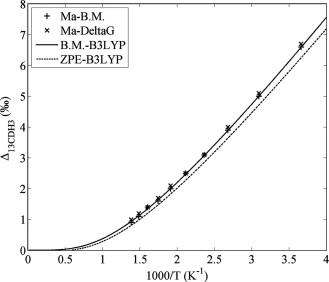Clumped isotope is an isotopologue which contains two or more rare isotopes, such as 18O13C16O. The clumped-isotope method was firstly established by Professor John Eiler and his colleagues in Caltech and opened up a new field of stable isotope geochemistry. Compared with traditional stable isotopes, clumped isotope has unique advantages. Although the abundance of such isotopologue is very low, usually on the order of 10-6, it can still be determined precisely by the recent techniques.
Surely existing in many molecules and compounds, clumped isotopes have the potential to provide information of many kinds of geological processes. Eiler’s group only developed one usage of clumped isotopes: determining formation temperature by one phase. However, this application alone was enough to make clumped isotope to become an exciting field. Professor John Eiler presented his new method in Gast Lecture at Goldschmidt 2006 conference. The 2009 EAG Science Innovation Award was awarded to him because of his leading contribution to this new field. Currently, in the United States, grants and faculty position offers of stable isotope geochemistry tend to be given to the scientists engaging in clumped isotopes, indicating that the potential of clumped isotopes has drawn more attention from overseas geoscientists.
In China, clumped isotope research was firstly carried out by Liu Yun’s Group at the Institute of Geochemistry, Chinese Academy of Sciences (IGCAS) (Tang Mao, Zhao Hui and Liu Yun, Acta Mineralogica Sinica, 2007). They translated “clumped isotope” into Chinese as “二元同位素”to distinguish it from the traditional stable isotopes. Recently, scientists at several universities in China start to be engaged in this field, implying that the importance of clumped isotope has been recognized by more and more domestic scientists.
 |
|
Figure The anharmonic correction to Δ13CDH3 varies with temperature. The harmonic results agree well with Ma et al. (2008). The anharmonic correction reduces Δ13CDH3 by about 0.2‰ from 0 to 450°C. (Image by IGCAS) |
|
|
The framework of clumped isotopes was firstly proposed by Eiler’s group (Wang et al., 2004). In their paper, they defined two basic notions: Δ
i and Δ
mass, and developed a method to calculate Δ
i and Δ
mass theoretically. Nevertheless, there are still many theoretical issues associated with clumped isotopes to be tackled, such as kinetic isotope effects, tedious calculation method, and no approximate method to deal with the molecules with isotopomers (e.g.,
15N
14N
16O and
14N
15N
16O), etc. Those issues have prevented scientists from providing more reasonable theoretical explanations of many experimental results.
Doctoral candidate CAO Xiaobin and his advisor Professor LIU Yun, both from the State Key Laboratory of Ore Deposit Geochemistry (SKLODG) at IGCAS, have improved the calculation in clumped-isotope method. Their work was published on Geochimica et Cosmochimica Acta (Cao and Liu, 2012, Theoretical estimation of the equilibrium distribution of clumped isotopes in nature, Geochimica et Cosmochimica Acta 77, 292-303).
In their paper, the variable Δi was converted to a notion based on free energy, highlighting the rules and behaviors of clumped isotopes. Unlike the method suggested by WANG et al. (2004), the approximate method proposed by CAO and LIU can handle molecules with isotopomers (e.g. 14N15N16O vs. 15N14N16O) and can estimate Δmass for any kind of molecule, no matter whether the Δi values of singly-substituted isotopologues are small or large. Because the proposed approximate method appears to consistently overestimate Δmass by 1 to 2 percent, a scale factor could further improve the results.
Besides the improvement of calculation method, CAO and LIU also developed some equations to describe the behaviors of clumped isotopes. Additionally, they have carefully studied the anharmonic effect (See the Figure) and scaling factor effect on clumped isotopes calculation. The above theoretical work will help improving the theoretical explanations of the clumped isotope experimental results.
(By CAO Xiaobin)